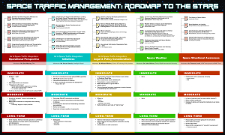Presentation Type
Paper (supporting PowerPoints may be added as Additional Files)
Location
Bass Auditorium
Start Date
26-2-2019 3:45 PM
Abstract
The exponential rise in small-satellites and CubeSats in Low Earth Orbit (LEO) poses important challenges for future space traffic management. At altitudes of 600 km and lower, aerodynamic drag accelerates de-orbiting of satellites. However, placement of satellites at higher altitudes required for constellations pose important challenges. The satellites will require on-board propulsion to lower their orbits to 600 km and let aerodynamic drag take-over. In this work we analyze solutions for de-orbiting satellites at altitudes of up to 3000 km. We consider a modular robotic de-orbit device that has stowed volume of a regular CubeSat. The de-orbit device would be externally directed towards a dead satellite or placed on one by an external satellite servicing system.
Our solutions are intended to be simple, high-reliability devices that operate in a passive manner, requiring no active electronics or utilize external beamed power in the form of radio frequency, microwave or laser to operate. Utilizing this approach, it is possible for an external, even ground based system to direct the de-orbit of a spacecraft. The role of an external system to direct the de-orbit is important to avoid accidental collisions. Some form of propulsion is needed to lower the orbit of the dead satellite or orbital debris. We considered green (non-toxic) propulsion methods including solar radiation pressure, solar-thermal propulsion using water steam, solar-electrolysis propulsion using water and use of electrodynamic tethers. Based on this trade-study we identify multiple solutions that can be used to de-orbit a spacecraft or orbital debris.
Area of Interest
Space Situational Awareness
Presentations
Awaiting acceptance notification.
Biographies
View boi for Aman Chandra
Advanced Inflatable De-Orbit Solutions for Derelict Satellites and Orbital Debris
Bass Auditorium
The exponential rise in small-satellites and CubeSats in Low Earth Orbit (LEO) poses important challenges for future space traffic management. At altitudes of 600 km and lower, aerodynamic drag accelerates de-orbiting of satellites. However, placement of satellites at higher altitudes required for constellations pose important challenges. The satellites will require on-board propulsion to lower their orbits to 600 km and let aerodynamic drag take-over. In this work we analyze solutions for de-orbiting satellites at altitudes of up to 3000 km. We consider a modular robotic de-orbit device that has stowed volume of a regular CubeSat. The de-orbit device would be externally directed towards a dead satellite or placed on one by an external satellite servicing system.
Our solutions are intended to be simple, high-reliability devices that operate in a passive manner, requiring no active electronics or utilize external beamed power in the form of radio frequency, microwave or laser to operate. Utilizing this approach, it is possible for an external, even ground based system to direct the de-orbit of a spacecraft. The role of an external system to direct the de-orbit is important to avoid accidental collisions. Some form of propulsion is needed to lower the orbit of the dead satellite or orbital debris. We considered green (non-toxic) propulsion methods including solar radiation pressure, solar-thermal propulsion using water steam, solar-electrolysis propulsion using water and use of electrodynamic tethers. Based on this trade-study we identify multiple solutions that can be used to de-orbit a spacecraft or orbital debris.



Comments
Visit the panel session Orbital Coordination: Part 2